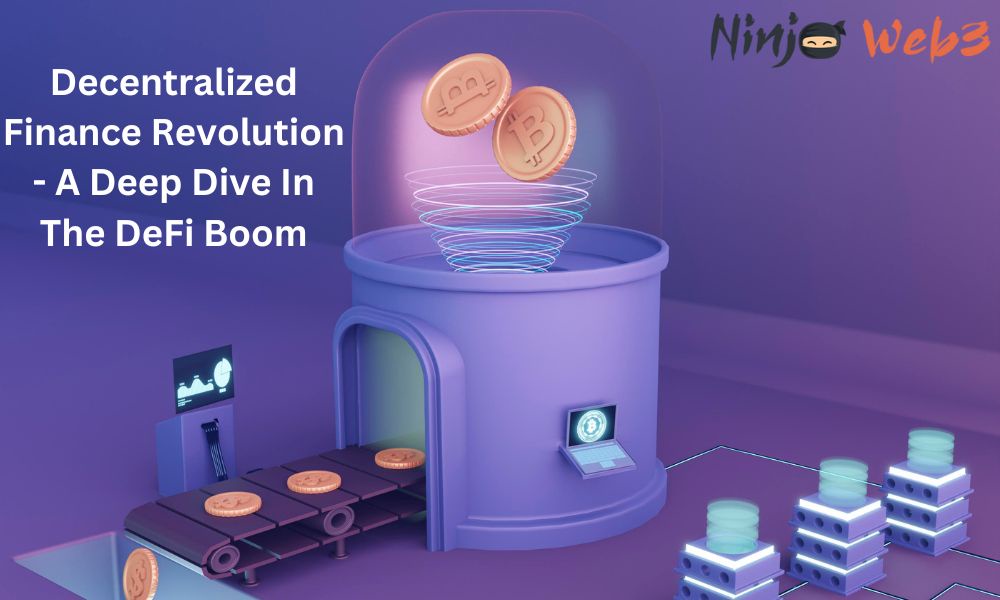In the dynamic landscape of finance, a revolutionary wave is transforming traditional banking and investment models. At the heart of this revolution is the rapid ascent of Decentralized Finance, commonly known as DeFi. This phenomenon has captured the attention of investors, tech enthusiasts, and financial experts alike. In this exploration, we embark on a deep dive into the fascinating rise of decentralized finance, unraveling its origins, key components, and the profound impact it's having on the financial industry. Visit us at Ninja Web3 for more updates and details.
Understanding Decentralized Finance
Decentralized Finance refers to a set of financial services and applications built on blockchain technology. Unlike traditional financial systems that rely on centralized intermediaries such as banks, DeFi operates in a decentralized manner. It leverages smart contracts—self-executing contracts with the terms of the agreement directly written into code—running on blockchain platforms like Ethereum. These smart contracts enable trustless and transparent transactions, eliminating the need for intermediaries.
The Foundations of DeFi
The roots of DeFi can be traced back to the launch of Bitcoin, the first decentralized digital currency. However, it was the introduction of Ethereum in 2015 that paved the way for the expansion of DeFi. Ethereum's programmable smart contracts allow developers to create decentralized applications (DApps) and financial services on its blockchain.
Key Components of DeFi
- Decentralized Exchanges (DEXs): These platforms facilitate peer-to-peer trading of cryptocurrencies without the need for a central authority. Uniswap and SushiSwap are prominent examples, providing users with decentralized trading experiences.
- Decentralized Lending and Borrowing: Platforms like Aave and Compound enable users to lend and borrow assets without intermediaries. Users can earn interest on deposited funds or access loans based on their crypto holdings.
- Stablecoins: These are cryptocurrencies pegged to the value of traditional fiat currencies, providing stability in a volatile market. USDC and DAI are widely used stablecoins in DeFi transactions.
- Yield Farming: This involves leveraging different DeFi protocols to maximize returns on cryptocurrency holdings. Users can stake or lock their assets in various protocols to earn additional tokens as rewards.
The DeFi User Experience
What sets DeFi apart is its user-centric approach. Anyone with an internet connection and a cryptocurrency wallet can access these decentralized services. This inclusivity opens up financial opportunities to a global audience, providing banking services to the unbanked and underserved.
The DeFi Boom in Action
Explosive Growth
Over the past few years, the DeFi space has witnessed exponential growth. The total value locked (TVL) in DeFi protocols surged from a few million to over $100 billion in a short span. This meteoric rise underscores the growing acceptance and demand for decentralized financial services.
Challenges and Risks
While DeFi presents exciting opportunities, it's not without challenges. Smart contract vulnerabilities, regulatory uncertainties, and market volatility pose risks to participants. Despite these challenges, the DeFi community continues to innovate and address shortcomings, emphasizing the resilience of the decentralized finance ecosystem.
Impact on Traditional Finance
The rise of DeFi is reshaping traditional finance in profound ways, challenging established norms and fostering a shift towards a more decentralized and inclusive financial ecosystem. As DeFi gains momentum, it prompts a reevaluation of traditional financial institutions' roles, pushing them to adapt to the evolving landscape of decentralized alternatives.
Disintermediation
DeFi eliminates the need for traditional intermediaries, such as banks and brokers, by providing direct peer-to-peer services. This disintermediation reduces costs, enhances efficiency, and increases financial inclusion.
Financial Inclusion
DeFi is unlocking financial services for individuals who were previously excluded from the traditional banking system. People in underserved regions now have access to banking, lending, and investment opportunities through their smartphones.
Paradigm Shift in Ownership
Decentralized Finance emphasizes ownership and control of assets. Users have complete control over their private keys and funds, contrasting with traditional finance where custody is often entrusted to third parties.
Challenges and Future Outlook
While the DeFi boom is transformative, challenges persist. Regulatory frameworks are still evolving, and security concerns need vigilant attention. However, the momentum suggests that decentralized finance is here to stay.
Regulatory Landscape
Regulatory clarity is crucial for the sustained growth of DeFi. Governments and regulatory bodies are grappling with how to categorize and oversee these decentralized financial services. Striking the right balance between innovation and protection will shape the future of DeFi regulation.
Continuous Innovation
The DeFi space thrives on innovation. Ongoing developments, such as decentralized autonomous organizations (DAOs), non-fungible tokens (NFTs), and cross-chain interoperability, promise to push the boundaries of what is achievable in the decentralized finance ecosystem.
Embracing the DeFi Revolution
In conclusion, the rise of decentralized finance marks a paradigm shift in how we approach and interact with financial services. The DeFi boom signifies more than just a trend; it represents a fundamental reimagining of the financial landscape. As we navigate the complexities and uncertainties, one thing is clear: decentralized finance is a force that cannot be ignored. Whether you're a seasoned investor or someone exploring financial possibilities for the first time, the world of decentralized finance awaits, offering a decentralized, inclusive, and innovative future for the global economy.
In the spirit of decentralization, the power to shape the future of finance is in the hands of the many, not the few. Welcome to the DeFi revolution.
Read some more:


No comments yet